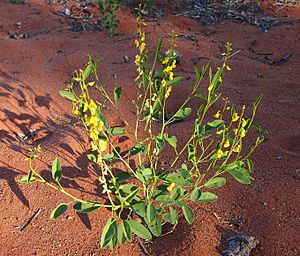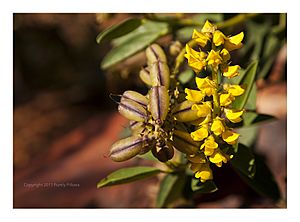Crotalaria novae-hollandiae facts for kids
Quick facts for kids Crotalaria novae-hollandiae |
|
|---|---|
 |
|
| Scientific classification | |
| Kingdom: | |
| (unranked): | |
| (unranked): | |
| (unranked): | |
| Order: | |
| Family: | |
| Subfamily: | |
| Tribe: |
Crotalarieae
|
| Genus: |
Crotalaria
|
| Species: |
C. novae-hollandiae
|
| Binomial name | |
| Crotalaria novae-hollandiae DC.
|
|
The Crotalaria novae-hollandiae, also known as the New Holland Rattlepod, is a type of flowering plant that grows naturally in Australia. It gets its name "Rattlepod" because its seed pods make a rattling sound when they are dry.
Contents
What is the New Holland Rattlepod?
The New Holland Rattlepod is a kind of flowering plant. It belongs to a group called Eudicots, which are a large part of all flowering plants. This plant is known for its bright yellow flowers and larger brown seed pods.
It is part of the Fabaceae family, which means it's a distant relative of plants like peas, lima beans, and lentils. Even though some plants in the Crotalaria group from other countries have edible flowers or seeds, the New Holland Rattlepod is known to be poisonous. It should never be eaten by humans or animals.
How Does the Rattlepod Look and Grow?
The Crotalaria novae-hollandiae grows as a shrub, which is like a small bush. It usually grows in sandy soils. This plant is an annual, meaning it completes its whole life cycle in one year.
It has dark green leaves and bright yellow flowers. These flowers grow together in a spike shape, which is called an inflorescence. The yellow flowers look a bit like a clog and have three petals that are not the same size.
The plant also has brown, club-shaped pods. When these pods are mature and dry, they rattle when shaken. This is why it's called a Rattlepod! These pods contain toxic chemicals called alkaloids. The rattling pods and their poisonous nature are likely a way for the plant to protect itself. This helps make sure animals don't eat them, as they can be harmful.
The New Holland Rattlepod can grow to about 80 centimeters (about 31 inches) tall. Its leaves are slightly pointed at the tip. The pods grow close together on the stem and hang down when they are fully grown.
Where Does the Rattlepod Live?
This plant often grows in sandy areas, especially near river banks and riverfronts. These places are often flooded when there's a lot of rain. For example, you can find it widely around the Victoria River in Australia.
The New Holland Rattlepod seems to do well in areas where the land has been disturbed. In good seasons, it can grow in thick patches. When it's flowering, its bright yellow color makes it very easy to spot.
Why is the Rattlepod Important?
Because of the alkaloids it contains, the Crotalaria novae-hollandiae is known to be a somewhat poisonous plant. It is not safe to feed the New Holland Rattlepod to farm animals like horses or cattle.
The plant has toxic elements that can be dangerous to these animals. Eating this plant can make them very sick and cause damage to their liver, lungs, and kidneys. It's important for farmers to keep their livestock away from this plant.


